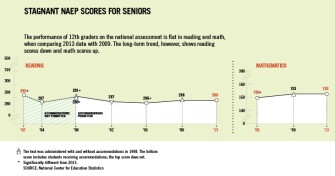High school seniors’ performance in mathematics and reading has stagnated since 2009, according to a new round of results from the National Assessment of Educational Progress.
The achievement data from NAEP, known as “the nation’s report card,” show that 12th graders’ average math score remained at 153, on a 300-point scale, when comparing the 2013 results with those from 2009. Just 26 percent of students scored at or above the proficient level in math—again the same as four years ago.
In reading, the national average stayed flat at 288, on a 500-point scale, with 37 percent of students scoring at or above proficient, according to the new NAEP report, issued May 7.

NAEP results are reported at three achievement levels: basic, proficient, and advanced. Proficient, for NAEP purposes, means students “have had success with the challenging content on that grade level,” said Cornelia Orr, the executive director of the National Assessment Governing Board, during a May 6 media call.
A nationally representative sample of about 92,000 12th graders took the test between January and March of 2013.
While scores in math and reading remain unchanged compared with four years ago, the national average for reading decreased by four points since the test’s first administration in 1992. In math, scores have increased by three points since 2005, when a new test framework was introduced. Results from prior to that time are not considered valid for comparison.
John Easton, the acting commissioner of the National Center for Education Statistics, which administers NAEP, said that since 1992, graduation rates have increased from 74 percent to 81 percent of students in a freshman class. For that reason, he said, the recent testing sample “includes more lower-performing students who would have dropped out in the past.”
In addition, the rates of students identified with disabilities and as English learners have gone up, and exclusion rates for the test have gone down. The percentage of white students has declined from 74 percent to 58 percent, and the Hispanic population has grown from 7 percent to 20 percent. (The population of black students has remained steady.)
However, Mr. Easton emphasized, “Our 12th grade population is our 12th grade population and we don’t explain away test scores based on demographics.”
Achievement Gaps Persist
When viewed by gender and race/ethnicity, both the math and reading scores have also remained unchanged since 2009, indicating that achievement gaps have persisted. The black-white gap continues to be the largest one, with black students scoring about 30 points below their white peers on both tests in 2013. Looked at another way, in reading, 47 percent of white students scored proficient or above, compared with 16 percent of blacks. And in math, 33 percent of white students scored proficient or above, while only 7 percent of black students did the same.
Here’s a chart from the National Center for Education Statistics showing proficiency rates in math by race and ethnicity:

Further, the score gap in reading between black and white students has increased by 5 points since 1992.
U.S. Secretary of Education Arne Duncan said in a statement about the results, “We project that our nation’s public schools will become majority-minority this fall—making it even more urgent to put renewed attention into the academic rigor and equity of course offerings and into efforts to redesign high schools. We must reject educational stagnation in our high schools, and as [a] nation, we must do better for all students, especially for African-American and Latino students.”
This is the second time NAEP has included results at grade 12 from individual states as part of a pilot program. States are required to participate in NAEP testing for 4th and 8th grades in order to receive federal aid under the No Child Left Behind Act. Starting in 2009, states could volunteer to receive individual state-based results at grade 12.
Arkansas, Connecticut, Florida, Idaho, Illinois, Iowa, Massachusetts, New Hampshire, New Jersey, South Dakota, and West Virginia all participated in both 2009 and 2013. This year, Tennessee and Michigan also participated.
Of the 11 states that received scores in 2009 as well, four showed improvement in math: Arkansas, Connecticut, Idaho, and West Virginia. Two states—Arkansas and Connecticut—showed improvement in average reading scores over the last four years.
Connecticut, Massachusetts, New Hampshire, New Jersey, and South Dakota outperformed the national average in both math and reading in 2013.
Connecticut had the highest percentage of students score at or above the proficient level in reading in 2013, with 50 percent. In math, Massachusetts had the highest percentage of those at or above proficient, with 34 percent.
Common-Core Connection
With new tests aligned to the Common Core State Standards set to debut next year, many people are wondering if NAEP offers any clues as to how high school students will perform. Ms. Orr from the National Assessment Governing Board, which sets policy for NAEP, called that “the million-dollar question.”
“How will [the two testing consortia] report scores out in terms of scales and proficiency levels, and how will those align with the NAEP scores in terms of proficiency levels—all of that is yet unknown,” she said. Even so, an initial review found that the NAEP test items are “quite closely aligned with the common-core content.”
Ms. Orr added that next week the governing board plans to release its first report on what NAEP results can say about how prepared students are for endeavors beyond 12th grade.


